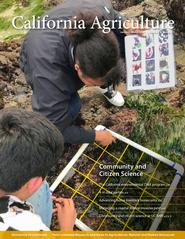All Issues

Students at the Pacific Grove Museum of Natural History (a California Naturalist Partner) participating in a coastal LiMPETS (Long-term Monitoring Program and Experiential Training for Students) survey. Photo by Pacific Grove Museum of Natural History.
Volume 75, Number 1
Peer-reviewed research and review articles
Youth participants in 4-H animal science projects are involved extensively with raising and exhibiting agricultural animals, often on backyard farms (Smith and Meehan 2012). Since backyard farms can serve as sources and vectors of pathogens (FAO 1999; WHO 2011), it is critical that 4-H youth take an active role in preventing the introduction and spread of economically important animal diseases. Fifteen 4-H youth from two counties in California participated in the 4-H Bio-Security Proficiencies Program, a long-term community and citizen science project focused on animal and zoonotic disease risk education and mitigation. Then, in the role of community science experts, they acted upon the risk assessments and mitigation plans they had developed to improve biosecurity practices and reduce the likelihood of disease spread on their home premises and at their local county fair. They also extended their knowledge to the broader livestock exhibition community through outreach videos.





